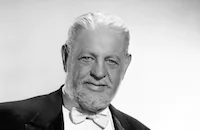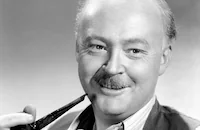The Lone Wolf Meets a Lady

Brief Synopsis
Cast & Crew
Sidney Salkow
Warren William
Jean Muir
Eric Blore
Victor Jory
Warren Hull
Film Details
Technical Specs

Synopsis
Michael Lanyard, a reformed jewel thief known as The Lone Wolf, nearly kills a woman while speeding to a winter resort. Stopped by the police, Lanyard and his personal valet, Jamison, along with the woman, Joan Bradley, are hauled off to police headquarters for questioning. En route, however, they manage to give the officer the slip, and Joan confides to Lanyard the part she has just played in a murder. Joan tells Lanyard that her ex-husband, Pete Rennick, whom she believed was dead, visited her on the eve of her marriage to millionaire Bob Penyon. While attempting to steal the diamond necklace that Bob gave her as a wedding gift, Pete was killed by a mysterious gunshot. Lanyard is intrigued by Joan's story and helps her buy time by furnishing her with an alibi. When Bob and the police investigators arrive, the police discover an inconsistency in her story and believe that she is hiding something. Secretly, Bob and Joan, who believe that they are about to be arrested, flee the apartment. Later, at Lanyard's home, Lanyard and Jamison are visited by Clay Beaudine, the mastermind behind the attempted robbery. Beaudine, convinced that Lanyard has reverted to his criminal past and is involved in the theft, insists that he enter into a partnership with him, but Lanyard resists his "offer." He then seeks the professional advice of his friend, Nick, a jeweler. Shortly after, Lanyard, posing as Inspector Crane, questions members of the Penyon family in their home. One member of the family, Rose Waverly, appears highly suspect in Lanyard's opinion, and he eventually coaxes her into confessing that she tipped off Beaudine in exchange for money that she desperately needed. Meanwhile, back at Lanyard's apartment, Beaudine forces his way in, and when he sees a newspaper article about the murder and recognizes the man in the picture, he locks Jamison and Joan in the bathroom. He then calls the man in the picture and arranges a rendezvous with him. When Lanyard returns home, he traces the address of Beaudine's destination through a dry cleaning ticket and follows him there, only to find Beaudine's recently murdered body. When Lanyard learns from Nick that the necklace was broken up and sold in pieces a year ago, he sets a trap for the killer by having Joan call Peter Van Wyck, a friend of the Penyons', to tell him that the jewels have been discovered at the bottom of a river and are about to be dredged up. Soon after Van Wyck arrives, Lanyard accuses him of the stealing the fake jewels to commit insurance fraud and of killing Pete to cover up the theft. Frightened, Van Wyck takes Joan hostage at gunpoint, but he is shot by Crane's quick-thinking assistant. The mystery solved, Joan and Bob are advised by Mrs. Penyon to marry as soon as possible, before some new intrigue spoils their wedding plans.

Director
Sidney Salkow
Cast

Warren William

Jean Muir

Eric Blore

Victor Jory

Warren Hull

Roger Pryor

Thurston Hall
Fred A. Kelsey
Robert Emmett Keane
Georgia Caine
William Forrest
Maria Shelton

Bruce Bennett
Charles Sherlock
Eddie Laughton

Don Beddoe
Richard Fiske
Ellen Lowe
Luis Alberni
Nellie V. Nichols
Houghton Ralph
Roger Gray
Crew
Lionel Banks
Irving Briskin
Al Clark
Ralph Cohn
George Cooper
Henry Freulich
Kalloch
Wolfe Kaufman
John Larkin
John Larkin
William Mull
Sidney Salkow
M. W. Stoloff

Film Details
Technical Specs

Articles
The Lone Wolf Meets a Lady
In The Lone Wolf Meets a Lady (1940), the second one starring William, Lanyard literally runs into a socialite accused of murder, and tracks down the real killer. The film also introduces a sidekick for Lanyard, his bumbling valet Jamison, played perfectly by the incomparable Eric Blore. Blore would play Jamison in seven more films. The New York Times had this to say about the film: "Never taking itself too seriously, the Lone Wolf's latest escapade merges as a better than average example of the prefabricated mystery thrillers."
Michael Lanyard was not William's first time playing a sleuth - he was the first onscreen Perry Mason, playing the crime-solving lawyer in four films based on Erle Stanley Gardner's novels; and he succeeded William Powell as Philo Vance, playing the dapper detective in two films. Tall and patrician looking, with a wonderful speaking voice and a theatrical background, William was one of Hollywood's busiest leading men in the early 1930s. He played predatory cads, amoral seducers, and shyster lawyers in the pre-code era under contract at Warner Bros. When William did play an occasional straight leading man, it was often on loanout to other studios, including twice opposite Claudette Colbert, in Imitation of Life (1934), and as Julius Caesar to Colbert's Cleopatra (1934), directed Cecil B. DeMille. After the Production Code went into effect, William's cads went out of style, and he left Warner Bros. in 1936. William worked less frequently, but steadily, until his death from cancer in 1948.
Jean Muir, who plays the "lady" of the title in The Lone Wolf Meets a Lady was also a former Warner Bros. contract player. She was signed by the studio in 1933, after a Broadway triumph, but never had a breakthrough role, although she appeared in an occasional prestige production like A Midsummer Night's Dream (1935). Disappointed, she returned to the stage in the late 1930s, and made only an occasional film thereafter. The Lone Wolf Meets a Lady was her next-to-last film. She worked in theater and television in New York, and in 1950 was blacklisted as a suspected communist. In the late 1960s, Muir turned to teaching acting at a college in the Midwest. She died in 1996.
William's final Lone Wolf film was Passport to Suez (1943). Gerald Mohr played the character in three more films, all with Eric Blore as Jamison. Mohr also played Lanyard on radio, and Louis Hayward played him on television.
Director: Sidney Salkow
Producer: Ralph Cohn
Screenplay: John Larkin, based on the story by Larkin and Wolfe Kaufman, based on the character by Joseph Louis Vance
Cinematography: Henry Freulich
Editor: Al Clark
Cast: Warren William (Michael Lanyard), Jean Muir (Joan Bradley), Eric Blore (Jamison), Victor Jory (Clay Beaudine), Warren Hull (Bob Penyon), Roger Pryor (Pete Renick), Thurston Hall (Inspector Crane), Fred Kelsey (Dickens), Robert Emmett Keane (Peter Van Wyck).
BW-71m.
by Margarita Landazuri

The Lone Wolf Meets a Lady
Quotes
Trivia
Notes
Although Hollywood Reporter production charts list actor John Tyrell in the cast, his appearance in the released film has not been confirmed. Censorship material in the MPAA/PCA Collection at the AMPAS Library indicates that in February 1940 the PCA informed Columbia that a number of changes in the script were necessary before the film could receive certification. Among the many demands by PCA were that the "radio announcer must not be characterized, in any way, as a pansy"; that the drinking in the film be "held to an absolute minimum"; that the hiccoughing be eliminated; that the "business of Pete slapping and cuffing Joan" be eliminated; that the film not reveal the details of the crime; and that there be "no showing of panties or other particularly intimate garments." For information on "The Lone Wolf" series, see entry above for The Lone Wolf Spy Hunt and consult the Series Index.














